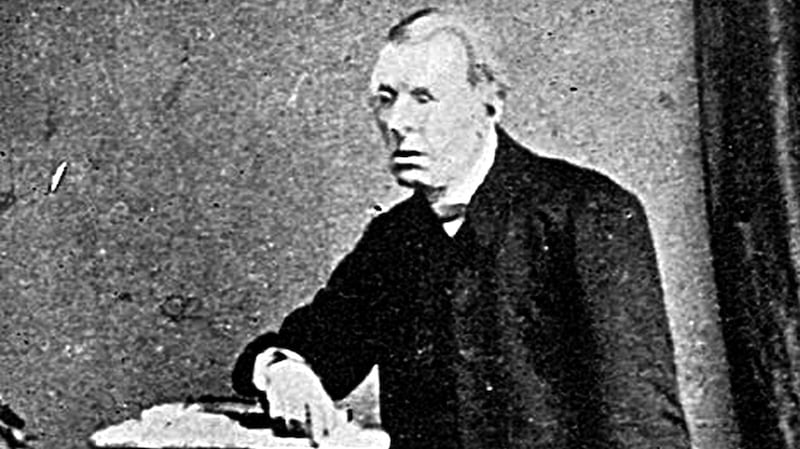If you were asked to describe how you think a curator of cuneiform tablets at the British Museum might look, you’d probably come up with an image very close to that of Dr Irving Finkel – bearded, scholarly, a bit old school, but with a lively light in his eyes and tremendous enthusiasm for his subject. Even his name seems to suit the job. He was in Dublin recently to deliver the Chester Beatty Lecture, given each year by a leading figure in their field. In each case the field is pertinent to the library’s collection, which is extensive and qualitatively outstanding.
Not surprisingly, Finkel is steeped in cuneiform, the ancient writing system in use for more than 3,000 years (more or less to the end of the first century AD) and using, mostly, the Sumerian and Akkadian languages of Assyria and Babylonia. Scribes used a reed stylus to impress marks into clay tablets. It is not an alphabet, Finkel emphasises, more a collection of syllables.
Crucially, vowels and consonants were not separated, nor were words, meaning that trained scribes, after several years study, had to have a repertoire of about 1000 characters at their fingertips. Cuneiform was ubiquitous and used in personal, business, cultural and official contexts.
A tablet is, at first glance, “a jumble of endless characters”. But, figure it out and you’ve got an extraordinary window on to a world, a world that is, Finkel has often pointed out, remarkably modern when you encounter it through cuneiform, inhabited by people very like us in their thoughts, feelings and general concerns in life.
The story of how cuneiform was figured out was at the heart of Finkel’s lecture. Specifically, he was highlighting the overlooked contribution of Cork-born parson Edward Hincks, a graduate of Trinity College whose pivotal achievement, he says, has been sidelined and overlooked.
Latterly, Kevin Cathcart has done a great deal to redress the balance, writing about Hincks and edited his collected correspondence, but more acknowledgement is needed. Finkel argues that Hincks’s role was deliberately obscured by orientalist Henry Rawlinson, who still receives the lion’s share of the credit.

Worse, Finkel says, when Hincks completed a stint at the British Museum, studying tablets there for a year, the institution held on to his research, which was accessed by Rawlinson. “In my experience, often the people who get the credit for discoveries and advances don’t deserve it.”
He says Ireland should do more to highlight Hincks’s significance. It could be that Hincks was, if not unworldly, not political in terms of his own academic reputation, perhaps a bit of a rough diamond – Finkel is sceptical of his official portrait, in which he appears almost suave. Which he was apparently not at all. Nor is his importance a recent discovery. Informed scholars were aware of his importance even in the 19th century and several voiced their views.
Finkel may be best known as the author of The Ark Before Noah, his 2014 book that detailed the origins and development of the story of Noah’s Ark in pre-biblical texts. Predictably, it did not go down well with biblical fundamentalists, but logic and the historical record are on his side: the narrative was altered to accommodate a biblical purpose and geographically shifted from a terrain where floods were a fact of life to a location that simply made no sense. Reviews were very positive and praised his writing for its liveliness and lucidity. “To be fair,” he notes, “the first version was written in a scholarly way. My editor called me, said he thought it was an amazing story, but could I possibly make it readable. So I rewrote it, in a direct, conversational manner, as though recounting it to someone. After all, it is a story that was relayed by itinerant storytellers. And it is an enduring template: heroic maverick saves the day. Hollywood is still churning them out.”
One of five children, Finkel grew up in a house full of music and books. Early visits to the British Museum convinced him, when he was just nine, that he would like to work there one day. Slightly by chance he began to study Assyriology, in Birmingham, and took to it so keenly that he followed it all the way through to a PhD and a research fellowship in Chicago, then back to England and the job he’d earmarked for himself as a child. In the best possible way, there is still something childlike in his enthusiasm, for Assyriology and a host of other subjects, some related, some less so.
As with The Ark Beyond Noah, the book he is working on – about 50 per cent written, he reckons – is another that has its roots in his core discipline but ventures further afield. He has long been struck by the prevalence of ghosts in Babylonian life, in stories – “there’s a huge literature” – and in day-to-day life, such as amulets beseeching a particular ghost to stop appearing to the wearer. He is not, he hastens to point out, claiming that ghosts are real or outlining a metaphysics that includes them. Rather, his point is that ghosts are, and have consistently been, embedded in human culture. Not unlike stories of the archetypal hero figure. Edward Hincks, as Finkel suggests, should number among them.












